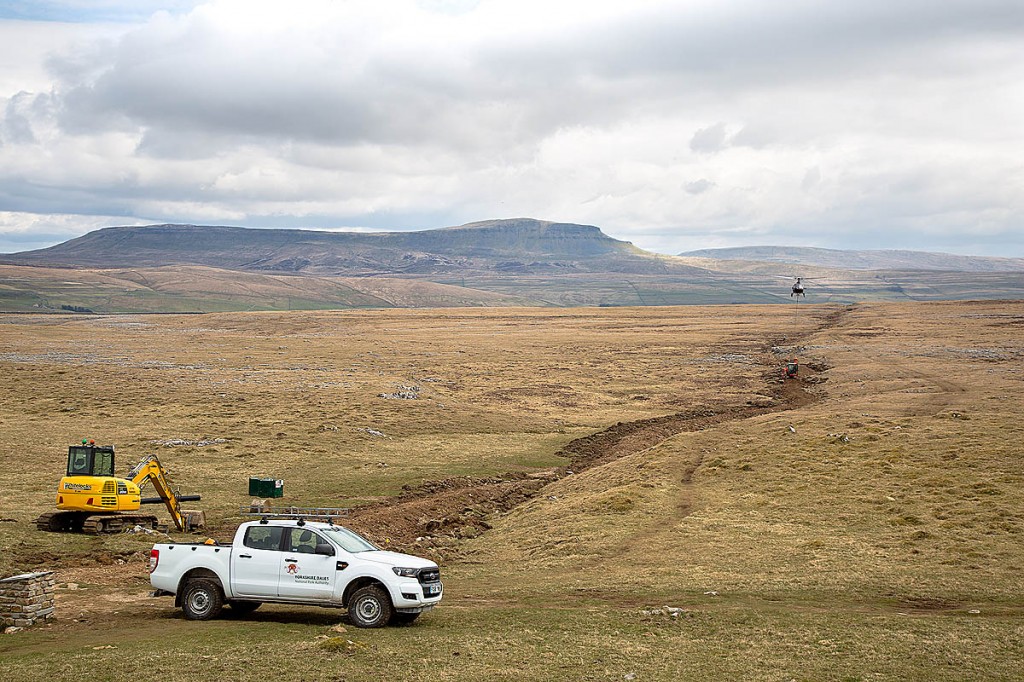National park rangers and volunteers are using more than 600 tonnes of stone aggregate to make the going easier for walkers on one of the Yorkshire Dales’ most popular routes.
The material is being airlifted to the slopes of Ingleborough from a quarry in nearby Horton in Ribblesdale.
The section of the path at Sulber is part of the Yorkshire Three Peaks challenge route, walked by an estimated 60,000 people every year.
The 1.6km (1-mile) path between the mountain’s summit and Sulber Nick has become badly rutted, resulting in people’s boots damaging a widening area as they seek to avoid boggy terrain. The erosion was putting at risk an important habitat for plants such as early purple orchid and bird’s eye primrose.
Rangers and volunteers from the national park authority are using the aggregate to engineer a 1.3 km path. The stone is being mixed with subsoil, from the line of the path, to create a hardwearing and free-draining surface. Culverts and cross drains are being installed along the way, while an additional 262m section over peat is being flagged with reclaimed stone.
Sulber Nick is on the final section of the Three Peaks route on the descent from Ingleborough to the traditional finishing point at Horton in Ribblesdale. It is in the Ingleborough national nature reserve. The works on the path are part of the three-year Ingleborough Access Project managed by the national park authority with £180,000 funding from Natural England. Last year’s repairs to the High Lot footpath were also part of the project.
Member champion for recreation management at the Yorkshire Dales National Park Authority, Nick Cotton said: “The Sulber Nick path has never been engineered, but anyone who has been there of late knows how much-needed these works are.
“The path has become so boggy that people are diverting to an adjacent ridge, which is an important habitat for early purple orchid, bird’s eye primrose, fell wort and Yorkshire sandwort. An engineered path, constructed in sympathy with the surroundings, will bring walkers once again to the correct path line and prevent further erosion.”
The aggregate has been donated from Horton Quarry owner Hanson UK.
Mr Cotton said: “Hanson UK has been very generous in gifting the huge quantity of aggregate required. Allowing the ranger service to use the northern tip of Horton Quarry as a helicopter lift site has also been a great help. Our thanks go to the company and its excellent local staff.”
Simon Garner, Hanson unit manager for the quarry, said: “We are delighted to be donating the stone needed to make the path safe and help protect the environment by encouraging walkers to use the designated route.
“Horton Quarry is an integral part of the area and we are happy to be able to support the local community in this way.”
People using the Three Peaks route, or walking to Ingleborough summit from Horton, are urged to follow advisory signs while the work is being completed.

TravellingLight
23 April 2021Sounds very much like a road?
Hope they can keep some sort of resemblance to a walking path. Always so sad to see hillsides scarred by our need for easy paths. No perfect solution I suppose...
Steve
24 April 2021Yes, I don't like their big stone slabs, where some gentle shale chippings would have done nicely.
Stuart Dodson
26 April 2021I like the slabs, I think they are repurposed from old mills.
Mike W
26 April 2021Most instances of 'hard' erosion control I now see and walk on are excellent - sympathetic to the landscape and built to last. There's no perfect answer but I'd sooner see and walk on such paths than see multiple, rutted and ever increasing splayed out paths.